Herbal Teas or Tisanes
'True' Teas
How to Use Infusers, Gaiwans & Yixing Teapot as part of Western vs Gong Fu Cha Brewing Methods
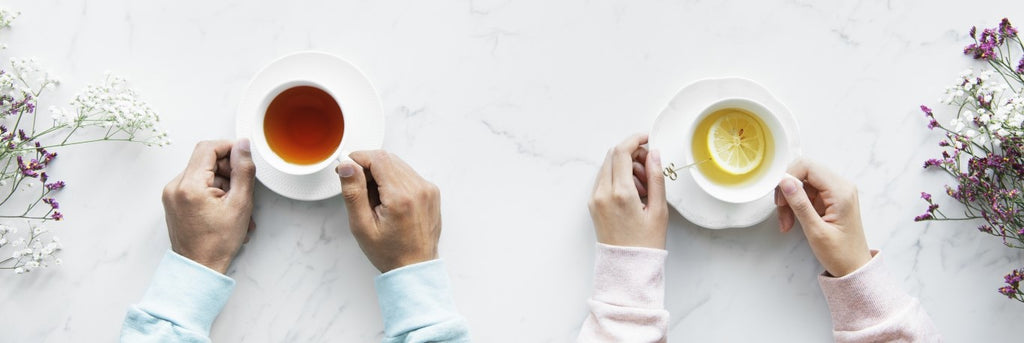
The difference between a great cup of tea and something that is best for watering plants is down to three key factors:
- Time: So your tea doesn't over- or under-brew i.e. too strong or too weak
- Temperature: Ensure that your water is the right temperature (some teas taste best in boiling water, whereas others will burn)
- Quantity: Check that you have used enough tea (to your taste of course!)
Let's set one thing straight: Loose leaf tastes much better. It is higher quality than the dust packed into teabags, which is often dried and minced into oblivion. It is also safer than teabags, as they are often coated in nasty chemicals and usually includes pesticides (Collective).
Loose leaf on the other hand can be washed (quickly under the faucet will do it) just as you would with fruit and vegetables. Tastes better and safer? Yes please! As you might have guessed, all of our teas are loose leaf.
All tea types have slightly different requirements to creating the perfect brew. Note that antioxidants tend to disappear after 3-4 hours of hot brewing, though with cold brewing the antioxidants can stick around for days (click here to read our post about this!).
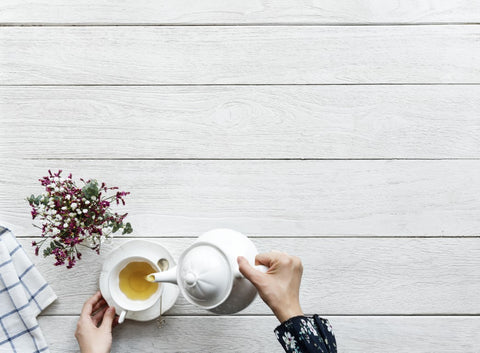
Herbal Teas / Tisanes Brewing Chart
First a quick summary for those in a rush to make some tea, and then details for once you've made your cup and need something to read:
|
212F (100C) |
1-2tsp |
8oz / 1 normal mug |
Shake, stir or whisk and it's ready to drink! Or add to cereal or anything you're cooking. E.g. a Moringa Dalgona. Moringa Protein Shake, or Moringa Chicken Stew |
|
| 212F (100C) |
1-2tsp |
8oz / 1 normal mug | Steep for 5+ minutes | |
| Tulsi | 212F (100C) | 1-2tsp (heaped) |
8oz / 1 normal mug | Steep for 5+ minutes |
| Honeybush and Rooibos | 212F (100C) | 1-2tsp (heaped) |
8oz / 1 normal mug | Steep for 5+ minutes |
| Yerba Mate | 100-170F (40-75C)* | 1-2tsp (heaped) |
8oz / 1 normal mug | Steep for 2-3 minutes |
*Just boil and leave the kettle for 5 minutes, or stop it as it starts to bubble at the edges. Or, for the stove-top, the water is ready when it starts simmering. If you burn your mate, it will go bitter.
If you are using a teapot, a general rule of thumb is a heaped spoonful per person and one for the pot. In other words, add another teaspoon to all the above measurements. ;-)
'True' Tea Brewing Chart (including for flavored tea)
| White Tea | ~160-200F (70-95C) (cooler for a milder tea, hotter for a stronger brew) | 2-3tsp (heaped) |
8oz / 1 normal mug |
Steep 1-9 minutes. The cooler the water, the longer the brew and the less caffeine, in general |
| Green Tea | ~120-180F (50-82C) (cooler for Japanese green teas, hotter for Chinese greens) | 1-2tsp (heaped) |
8oz / 1 normal mug | Steep 1-3 minutes |
| Purple Tea | ~160F (71C) | 1-2tsp (heaped) |
8oz / 1 normal mug | Steep 3 minutes |
| Oolong Tea | ~180-205F (82-96C) | 1-2tsp (heaped) |
8oz / 1 normal mug | Steep 1.5-2 minutes Rinse the leaves in hot water prior to brewing for best results |
| Black Tea | ~190-212F (88-100C) | 1-2tsp (heaped) |
8oz / 1 normal mug | Steep 2-5 minutes |
If you are using a teapot, a general rule of thumb is a heaped spoonful per person and one for the pot. In other words, add another teaspoon to all the above measurements.

Now for the detailed brewing instructions by tea type...
How to Brew Rooibos and Honeybush
Spoon tea leaves into your infuser (a tea ball, a strainer, a DIY teabag, or straight into your teapot). Use 1-2 tsp (heaped) for a mug, and for a pot, add a heaped spoonful per person plus one 'for the pot'.
Briefly rinse under the faucet and then pour over freshly boiled water (212F / 100C) and steep for 5-7 minutes. Don't worry, a quick wash with cold water won't remove the taste if you're making a blended tea.
If you want a stronger flavor, add another teaspoon of leaves and steep for 5 minutes. (Steeping longer won't make it bitter, but with rooibos extensive steeping can result in a slightly metallic flavor.)
For rooibos iced tea, follow the same steps, but add double to triple the quantity of tea per mug of water added to the teapot or pitcher. Why? Because we can't taste cold as well as hot or warm, so we need to make the flavor stronger. Also, most people add ice cubes to their ice tea, which of course waters it down further.
Let it steep for around twenty minutes. Then put in the fridge, or pour directly over ice. If desired, add sweeteners, lemon wedges or herb sprigs like mint. Note that the antioxidants tend to disappear after 3-4 hours of hot brewing.
You can also cold-brew your rooibos and honeybush: follow the same steps as above, but use cold water instead of hot and leave it in the fridge overnight. This also preserves the antioxidants so they last much longer.

How to Brew Tulsi Holy Basil
The only rule when steeping Tulsi is don't burn it. Apart from that, time and quantity are quite flexible but in general it makes a strong cup of tea.
Spoon tea leaves into your infuser (a tea ball, a strainer, a DIY teabag, or straight into your teapot). Start with 1-2tsp (heaped) for one mug of tea, and for a pot, add a heaped spoonful per person plus one 'for the pot'. Boil water, then let it sit for a minute OR pour it into another vessel before pouring it over your rinsed leaves.
Avoid using water that's hotter than 200F (93C), and because boiled water initially cools down very fast just leaving it for a little while will do the trick.
Steep for 5-8 minutes. If you want a stronger flavor, add another teaspoon of leaves and steep for 5-6 minutes (better to increase the amount of tea rather than the brewing time if you're after the maximum amount of antioxidants). To get the full antioxidant hit, ensure it steeps for minimum 5 minutes.
For tulsi iced tea, follow the same steps, but add double to triple the quantity of tea per mug of water added to the teapot or pitcher. Why? Because we can't taste cold as well as hot or warm, so we need to make the flavor stronger. Also, most people add ice cubes to their ice tea, which of course waters it down further.
Let it steep for around fifteen minutes+. Then put in the fridge, or pour directly over ice. If desired, add sweeteners, lemon wedges or herb sprigs like mint. Note that the antioxidants tend to disappear after 3-4 hours of hot brewing.
You can also cold-brew your tulsi tea, follow the same steps as above, but use cold water instead of hot and leave it in the fridge overnight. This also preserves the antioxidants so they last much longer.
Learn about why Tulsi is such an interesting tea
Try our Tulsi Holy Basil teas - prepare to be wowed
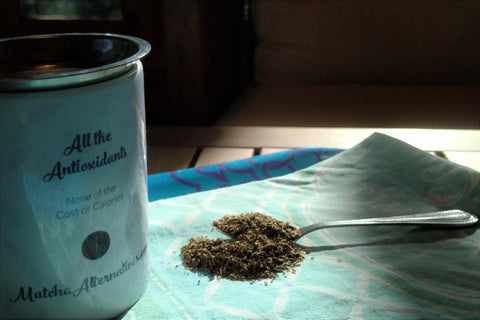
How to Brew Moringa
If you're familiar with how to make matcha, then you already know how to make moringa. Because it is powdered moringa leaf, it doesn't have a steeping time, and it's simply a question of how to add the powder to your water.
There are two ways:
1) Use your matcha chawan and chasen (bowl and whisk, in English). Add 1tsp powder for a thinner tea, and 3tsp for a thicker drink (in both cases, make sure they are heaped). Pour over freshly boiled water (212F/100C) and whisk in a figure-eight motion until frothy.
If you don't have a bowl and whisk, you can also add your moringa powder and water to a heat-proof glass jar and shake to mix. ONLY do this, though, if your jar is designed to hold boiling water, such as a thermos, as otherwise you'll burn yourself or the jar will shatter. This is a common way to mix matcha as well, if you don't have a chawan and whisk.
2) Spoon 1-2tsp (heaped) into a mug and add boiling water. Stir with a spoon and it's ready to drink.
If you want a stronger flavor, add another half teaspoon of powder. It can also be added straight to your smoothies or water bottle.
For iced moringa, simply stir the powder into cold water and enjoy! This is how it is commonly consumed in India.
Read our blog post about Moringa and our two-part series on adaptogens, the hero of the plant world
Try our Superior Organic Moringa Tea Powder to see what it's such a great alternative to matcha!

How to Brew Chamomile
Brewing chamomile is nice and easy as it doesn't burn.
Spoon tea leaves into your infuser (a tea ball, a strainer, a DIY teabag, or straight into your teapot). Use 1-2tsp for one normal-sized mug, or for a pot, add a heaped spoonful per person plus one 'for the pot'. Pour over freshly boiled water (212F/100C). Steep for 5 minutes. Because this tea is quite 'fluffy', use heaped spoonfuls and err on the generous side!
However, if you want a stronger flavor, add another heaped teaspoon of leaves and steep for 2-3 minutes. (Steeping longer, surprisingly, doesn't enhance the flavor and instead results in a slightly bitter brew.)
For chamomile iced tea, follow the same steps, but add double to triple the quantity of tea per mug of water added to the teapot or pitcher. Why? Because we can't taste cold as well as hot or warm, so we need to make the flavor stronger. Also, most people add ice cubes to their ice tea, which of course waters it down further.
Let it steep for around twenty minutes. Then put in the fridge, or pour directly over ice. If desired, add sweeteners, lemon wedges or herb sprigs like mint. Note that the antioxidants tend to disappear after 3-4 hours of hot brewing.
You can also cold-brew your chamomile tea: follow the same steps as for iced tea but use cold water instead of hot and leave it in the fridge overnight. This also preserves the antioxidants so they last much longer.
To learn more, check out our blog post about Chamomile and its sleep benefits
Explore our Chamomile Collection
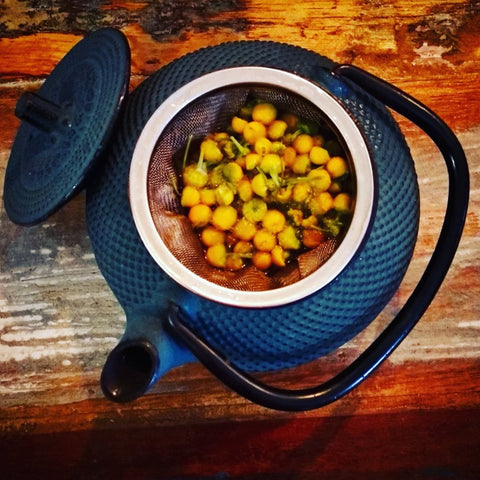
How to Brew Yerba Mate
Yerba mate has a long and complex brewing history, partially due to its extreme sensitivity to heat (it burns really easily!). However, we don't all need to follow the traditional brewing method so have come up with a more 'every day' method below.
1) In a mug or teapot with an infuser. Use 1-2tsp for one normal-sized mug, or for a pot, add a heaped spoonful per person plus one 'for the pot'. Fill your kettle and pour a small splash of cold water over the leaves (just a quick pour, ~1tbsp just enough to wet the leaves). Let the kettle boil and leave it to cool for ~5 minutes, then pour 8oz water over the tea (that's a standard mug). Steep for 2-3 minutes and enjoy!
If you're boiling the water on a stove, you can just wait until the water starts simmering and then pour over the leaves. (Using boiling water will burn the fragile leaves, destroying their nutrients and giving them a bitter taste so this is why 100-170F water is recommended.)
2) In a mate gourd with a bombilla (see photo below). This is the traditional Argentinian and Brazilian way to drink mate.
Start by adding a LOT of mate (3-5 Tbs, not teaspoons!) to your gourd (this can be made from an actual dried and seasoned gourd, or from ceramic or metal). Once the gourd is 2/3 full of leaves, tilt it so the leaves are piled against one side. Pour a small amount of cold water onto the side with fewer leaves and wait one minute for the water to be absorbed.
Insert your straw (the bombilla, a straw with a filter at the bottom) into the moistened part until it hits the bottom of the gourd. Carefully pour over hot water (100-170F / 38-81C) down along the straw until the gourd is full. A lot of froth should appear.
Drink and repeat until the leaves no longer froth or the flavor goes. Because of the sheer quantity of tea, you can usually repeat this process 7-8 times! However, due to mate's significant caffeine content (roughly the same as coffee), this is NOT advisable if you need to fall asleep any time soon...
3) Yerba mate iced tea. Follow the same steps, but add double to triple the quantity of tea per mug of water added to the teapot or pitcher. Why? Because we can't taste cold as well as hot or warm, so we need to make the flavor stronger. Also, most people add ice cubes to their ice tea, which of course waters it down further.
Let it steep for around twenty minutes. Then put in the fridge, or pour directly over ice. If desired, add sweeteners, lemon wedges or herb sprigs like mint. Note that the antioxidants tend to disappear after 3-4 hours of hot brewing.
You can also cold-brew your yerba mate tea: follow the same steps as iced tea, but use cold water instead of hot and leave it in the fridge overnight. This also preserves the antioxidants so they last much longer.
To learn more about yerba mate, have a look at our blog introducing this seriously caffeinated wonder-tea
Shop our Yerba Mate collection
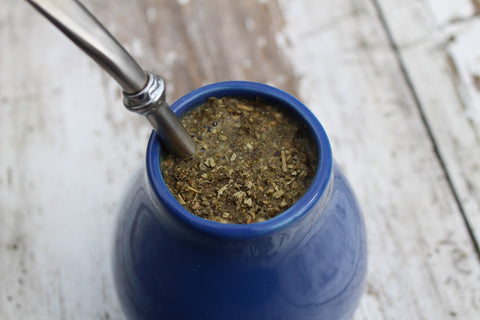
How to Brew Purple Tea
Purple tea is a type of green tea, but with a lot of natural anthocyanins (the same antioxidant in blueberries) in the leaves that turn it purple. It should therefore be brewed in the same way as a green tea: delicately.
Boil your water in a kettle, and then leave for 5 minutes to cool (approx 160F / 70C), or if using a stove top, the water is ready when it starts simmering. Then rinse 1-2tsp (heaped) of leaves with this cooler water, discarding the rinse water. This 'wakes up' the leaves and removes small particles that can make it bitter. You can also use a splash of tap water if you prefer.
Then pour over 8oz (one mug) of water. Don't use boiling water! Boiling water will burn the delicate leaves and destroy their health benefits too.
Steep for 2-3 minutes. Because this is a true tea (Camellia sinensis), brewing for too long will result in a bitter drink. If you want a stronger flavor, use more leaves and steep for the same or slightly less time.
For iced purple tea, double to triple the quantity of tea per mug of water added to the teapot or pitcher. Why? Because we can't taste cold as well as hot or warm, so we need to make the flavor stronger. Also, most people add ice cubes to their ice tea, which of course waters it down further.
Let it steep for around twenty minutes. Then put in the fridge, or pour directly over ice. If desired, add sweeteners, lemon wedges or herb sprigs like mint. Note that the antioxidants tend to disappear after 3-4 hours of hot brewing.
You can also cold-brew your purple tea: follow the same steps as above, but use cold water instead of hot and leave it in the fridge overnight. This also preserves the antioxidants so they last much longer.
To learn more about purple tea, read our Spotlight on Purple Tea
If you want to try, our 'The Purist' Rare Purple Tea is the answer

How to Brew White Tea
We love white tea, not only because it tastes great but also because it is so versatile. White tea is made with minimal processing (it isn't roasted or fried or steamed unlike black and green teas), which preserves most of its antioxidants.
It can be made from any leaves on the tea bush, with Silver Needle White Tea being made from only the leaf buds (see photo below) and Bai Mu Tan / White Peony White Tea being made from a 50-50 mix of buds and mature leaves.
A good rule of thumb for guiding your brewing: The younger the leaf, the more caffeine, and the hotter the water, the more caffeine is extracted. Some people prefer to brew at a lower temperature for longer, and others the reverse. The results are often quite different tasting drinks, all made from the same tea leaves!
In general: Use 2-3tsp of tea (you'll discover that white teas are 'fluffier' with a lot of air between the leaves, so you may even need 4 to 5 spoonfuls to get the perfect amount). If you have a scale, a good rule of thumb is 2 grams of tea for 100ml of water in a teapot, or 3-5 grams for 100ml water if using a gaiwan/ brewing Gong Fu style (see below for more about these methods).
Using water that has just started simmering, quickly rinse the tea and discard the water. This 'wakes up' the leaves and makes the taste that much richer.
Pour over a mug's worth of hot water, ranging anywhere from ~160-200F (70-95C). Let it steep for anywhere between 1-9 minutes. Here's why:
The cooler the water, the longer you will need to brew it (some Silver Needles need to brewed for up to 9 minutes!). The hotter the water, the shorter the brew AND the more caffeine. Tea leaf buds have the highest caffeine, and the caffeine will come out when brewed at a high temperature (i.e. 200F).
For Bai Mu Tan, though, you can brew it hot and there still won't be much caffeine, as the leaves are older. (I like to let my Bai Mu Tan steep for 5 minutes at 200F and am still okay drinking it in the evening.)
If you're not sure, start out brewing all your white tea at 200F (95C) and if your tea is bitter, drop the temperature. Most white teas can take the heat though!
For iced white tea, double to triple the quantity of tea per mug of water added to the teapot or pitcher. Why? Because we can't taste cold as well as hot or warm, so we need to make the flavor stronger. Also, most people add ice cubes to their ice tea, which of course waters it down further.
Let it steep for around twenty minutes. Then put in the fridge, or pour directly over ice. If desired, add sweeteners, lemon wedges or herb sprigs like mint. Note that the antioxidants tend to disappear after 3-4 hours of hot brewing.
You can also cold-brew your white tea: follow the same steps as above, but use cold water instead of hot and leave it in the fridge overnight. This also preserves the antioxidants so they last much longer.
To learn more about white tea, read our Spotlight on White Tea
Shop our White Tea Collection
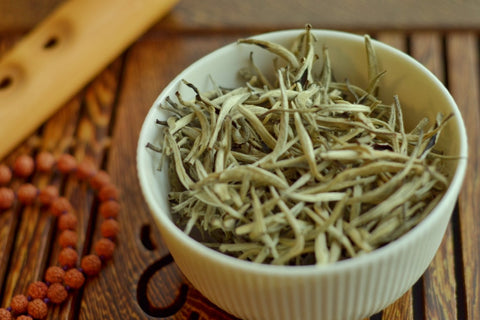
How to Brew Green Tea
In general, green tea is delicate and burns easily. When it burns, it becomes bitter and astringent, and probably tastes like the green teas you've had in restaurants and diners.
When it ISN'T burned, you will discover a whole range of personalities. Some are extremely sensitive to heat (Japanese green teas like gyokuro and sencha are good examples) and others are able to handle near-boiling water without issue (e.g. hojicha).
In general: use 1-2tsp (heaped) of green tea depending on how densely packed the leaves are. For example, only use 1tsp for our Tenderly Sweet Classic Sencha Green Tea, but use 2tsp+ for the looser Flowery Osmanthus Tea.
Boil your water in a kettle, and then leave for 5 minutes to cool (approx 120-180F / 50-82C), or if using a stove top, the water is ready when it starts simmering. Rinse your tea leaves, discarding the rinse water. This 'wakes up' the leaves and removes small particles that can make it astringent. You can also use a splash of tap water if you prefer.
Pour over 8oz (one mug) of water. Steep for 1-3 minutes. Because this is a true tea (Camellia sinensis), brewing for too long will result in a bitter drink. If you want a stronger flavor, use more leaves and steep for the same or slightly less time.
Use cooler water for Japanese green teas and hotter for Chinese greens. There are some powerful senchas and gyokuros that will brew perfectly in only 5 seconds, and some Dragonwells that require 3-4 minutes, so play around with your timings. When in doubt, try a sip and then decide if it tastes good or if it needs a bit more or less time.
For iced green tea, double to triple the quantity of tea per mug of water added to the teapot or pitcher. Why? Because we can't taste cold as well as hot or warm, so we need to make the flavor stronger. Also, most people add ice cubes to their ice tea, which of course waters it down further.
Let it steep for around twenty minutes. Then put in the fridge, or pour directly over ice. If desired, add sweeteners, lemon wedges or herb sprigs like mint. Note that the antioxidants tend to disappear after 3-4 hours of hot brewing. Green teas make for some of the most beautiful iced teas!
You can also cold-brew your green tea: follow the same steps as above, but use cold water instead of hot and leave it in the fridge overnight. This also preserves the antioxidants so they last much longer.
Learn more about green tea types here
If you're keen to try some green teas, check out our Green Tea collection!

How to Brew Black Tea
Black tea is fully oxidized tea and is tough! It doesn't burn and you can pour boiling water straight onto it without worry. In fact, black tea tends to taste bad when it's NOT brewed with boiling water, the rookie mistake most restaurants and cafes make.
The only note of caution with black tea is that re-steeping the leaves can bring out the bitterness from the leaves, so your second brewing is unlikely to taste anywhere near as good as the first (unlike oolongs).
In general, Use 1-2 tsp (heaped) for a mug, and for a pot, add a heaped spoonful per person plus one 'for the pot'. Briefly rinse under the faucet, this removes small particles that can make it astringent and leave sediment at the bottom of your mug.
Pour over 8oz (one mug's worth) of boiling, 212F (100C) water.
Steep for 1-3 minutes. Because this is a true tea (Camellia sinensis), brewing for too long will result in a bitter drink. If you want a stronger flavor, use more leaves and steep for the same or slightly less time.
For iced black tea, double to triple the quantity of tea per mug of water added to the teapot or pitcher. Why? Because we can't taste cold as well as hot or warm, so we need to make the flavor stronger. Also, most people add ice cubes to their ice tea, which of course waters it down further.
Let it steep for around twenty minutes. Then put in the fridge, or pour directly over ice. If desired, add sweeteners, lemon wedges or herb sprigs like mint. Note that the antioxidants tend to disappear after 3-4 hours of hot brewing. Black tea makes a classic iced tea that is delicious with slices of orange or lemon.
You can also cold-brew your black tea: follow the same steps as above, but use cold water instead of hot and leave it in the fridge overnight. This also preserves the antioxidants so they last much longer.
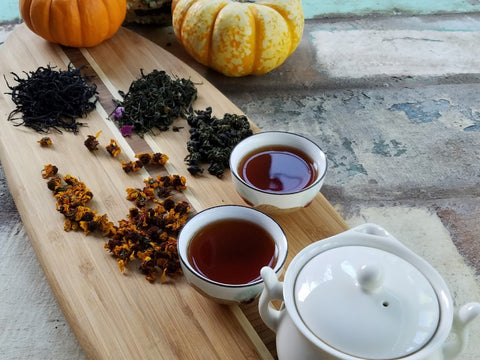
How to Brew Oolong Tea
Oolong is a halfway-house tea that is in between green tea (barely oxidized) and black tea (100% oxidized). Because of this, oolongs are technically anywhere between 7% and 95% oxidized, which results in a vast range of flavors.
In general, use 1-2tsp (heaped) of tea (less for dense, rolled oolongs and more for loosely packed leaves). The tight balls expand a LOT!
Boil your water in a kettle, and then leave for 2-3 minutes to cool 185-212F (85-100C), or if using a stove top, the water is ready when it is just starting to boil but is not in a rolling boil. Rinse your tea leaves, discarding the rinse water. If you are rinsing balled oolong, you can let the balls sit in the water for several seconds. This 'wakes up' the tea and makes the taste that much richer, as well as removing dust and other particles that won't taste great.
Pour over a mug's worth of hot water (around 8oz). Let it steep for anywhere between 30 seconds and 3 minutes. Use cooler water for loose leaves, and hotter water for balled oolong.
Oolongs generally can be re-steeped multiple times, with high quality oolongs sometimes going up to ten times (when brewed using a gong fu teapot, see below)! The second and third brewings are considered to be the richest, and the taste varies considerably between these steepings.
For iced oolong tea, double to triple the quantity of tea per mug of water added to the teapot or pitcher. Why? Because we can't taste cold as well as hot or warm, so we need to make the flavor stronger. Also, most people add ice cubes to their ice tea, which of course waters it down further.
Let it steep for around twenty minutes. Then put in the fridge, or pour directly over ice. If desired, add sweeteners, lemon wedges or herb sprigs like mint. Note that the antioxidants tend to disappear after 3-4 hours of hot brewing. You can of course use roasted or unroasted, however the most common is roasted as it has a stronger flavor.
You can also cold-brew your oolong tea: follow the same steps as above including 'waking the leaves', but use cold water instead of hot and leave it in the fridge overnight. This also preserves the antioxidants so they last much longer.
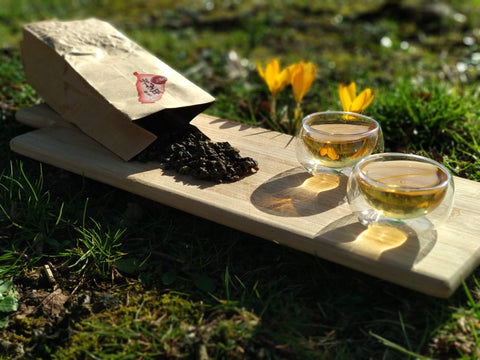
How to Use Infusers vs Gong Fu Cha Teaware
Infusers are the tools that help you get the flavor out of your tea leaves and into your cup. They are usually made of metal, but sometimes are made of glass, bamboo or silicone.
Gong fu cha brewing doesn't use infusers, but instead brews the leaves directly in the pot with multiple infusions. When you pour, you decant all of the brewed tea, filtering it as you pour.
Gong fu cha is the Chinese tea ceremony, and translates to "to brew tea with skill". In a gong fu cha ceremony, it may take hours and will always be a peaceful shared experience with all guests contemplating on the joys of good tea. It has also become known as a brewing method, hence the rise of "gong fu cha brewing" vs the "gong fu cha ceremony".
For a fantastic history and commentary on the gong fu cha ceremony, check out Tea Leaves and Tweed's post Difficult History: Gong Fu Cha Isn’t the One True Chinese Tea Practice.
The Main Western Infusion Methods for Brewing Loose Leaf Tea
Tea Balls
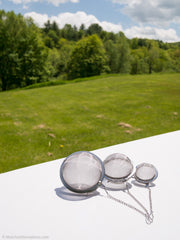 This is the most common infuser type. It is a mesh ball that hangs in your mug or teapot and is very easy to use. Simply spoon the dry tea in, clip shut and pop into your container. It is also simple to clean afterwards, and can be run through the dishwasher too. The main consideration is to not overpack your tea ball, as the leaves need to be able to expand and move in the water. We have a set of them if you want to experiment with different sizes.
This is the most common infuser type. It is a mesh ball that hangs in your mug or teapot and is very easy to use. Simply spoon the dry tea in, clip shut and pop into your container. It is also simple to clean afterwards, and can be run through the dishwasher too. The main consideration is to not overpack your tea ball, as the leaves need to be able to expand and move in the water. We have a set of them if you want to experiment with different sizes.
DIY Teabags
 These are great if tea balls are bit too fussy for you, this is because disposable teabags that are fully compost-able. Simply spoon tea into the bag, tuck in the top flap and drop into your mug or teapot. They are very useful for iced tea, too.
These are great if tea balls are bit too fussy for you, this is because disposable teabags that are fully compost-able. Simply spoon tea into the bag, tuck in the top flap and drop into your mug or teapot. They are very useful for iced tea, too.
For quantity, use 1-1.5tsp per cup. If you're brewing a big pot, add an extra 1tsp for good measure. These can be reused, and once you've steeped all the flavor out, they can be composted. If you haven't composted with tea before, learn all about that here!
Strainers
 Although tea balls and make-your-own teabags are popular for their ease, they prevent the leaves moving and unfurling completely, and so the taste isn't as full and rich as it could be. Loose leaf tea, when poured directly into your teapot, can move and expand without restriction. Result? A superb pot of full-flavored tea. However, how do you strain it?!
Although tea balls and make-your-own teabags are popular for their ease, they prevent the leaves moving and unfurling completely, and so the taste isn't as full and rich as it could be. Loose leaf tea, when poured directly into your teapot, can move and expand without restriction. Result? A superb pot of full-flavored tea. However, how do you strain it?!
With a strainer of course! Strainers fit onto most sizes of mug and tea cup and can either rest on the cup or be held while the pot is being poured. The drawback of strainers is that the leaves are still in the pot, steeping away, and so unless you pour the entire teapot immediately, your second cup will be overbrewed.
For this reason, loose leaf brewing with a strainer is best if you making tea for a group or have a single-cup teapot (our 19oz Quintessential teapot is perfect for tea for two, and is glass so you can see just how much tea is left). This is also the most traditional form of Western-style tea brewing.
Note: These are only used with teapots, not for mugs! The strainer in the photo is our Standalone Mesh Strainer with Hook & Drip Bowl, it's lovely.
If you are in need of an infuser, teabag or teapot, check out our teaware collection
What are the Two Main Gong Fu Cha Teaware Types?

Gaiwan
Gaiwans are basically large cups with fitted lids and no handles. Invented during the Ming dynasty, they only became popular in the 18th century as a quick and easy way to prepare tea for customers and traders. Previously, the Chinese tea ceremony took significant time and attention, which meant that one customer might use up hours of time better spent selling more items.
The gaiwan is wonderfully versatile, as it is usually porcelain and therefore doesn't absorb the flavor the tea leaves. It's most commonly used for brewing cooler teas, such as white and green, as the porcelain doesn't hold the heat as well as clay.
To serve, the lid is used to hold the tea leaves back. The tea is decanted into a "fairness pitcher", and then poured into your guests' cups.
For brewing, a high ratio to tea to water is used, with around 5tsp of tea to 5oz of water. The tea is then steeped for a shorter (but more intense!) time, somewhere between 20-60 seconds. Start with a rinse bath, and immediately pour out the waste water, rinsing your cups and fairness pitcher.
For your first brew, start with 30-35 seconds and go from there. The second brewing is likely to take less time, as the leaves have "woken up", and may only require 20-25 seconds. For subsequent brewings, increase the time by about 10 seconds per brewing. However, this will vary signfiicantly by each tea and your water temperature, so you will need to experiment to find the perfect length of time!
Fun Fact: There are even brewing apps available for your smart phone that allow you to add your tea and track the times for each steep, so that you can record and remember what the sweet spot was for each of your teas. We've used SteepedApp and Incremental Tea Timer and really enjoy using technology to tea responsibly. :-P

Yixing Teapot
This is a small Chinese teapot that usually only holds, at most, 8oz of water. These are also known are purple clay teapots, from the high quality clay in the Yixing area of Jiangsu proviced. However, due to the economics of supply and demand, a true purple clay teapot nowadays is incredibly expensive, and most Yixing teapots are made with another type of clay (or sometimes even glass or metal).
These teapots have been used across Chinese for centuries, thanks to their portability and small serving size. With gong fu cha brewing, the high tea:water ratio means multiple brewings are possible, so it makes sense to have your first brew, drink it, and then brew a second time, or third, or fourth. They also add ceremony to brewing, and a social aspect as the teacups used with Yixing teaports are traditionally only three sips' worth of tea, so you can share your brew with friends.
To brew, use around 5g of tea, which may well fill the pot. Rinse the leaves by filling the pot and immediately pouring out, using the water to wash your cups and fairness pitcher, if using.
For the first brew, start with steeping only 20-25 seconds - due to the quantity of tea, that may be sufficient! Second brewings are normally a bit faster, and then subsequent brewings you can usually add 10 seconds to each brew time.
Note, this varies considerably by tea type, and even by the individual tea, so you will need to experiment!
Our teaware collection, enjoying being photographed on a summer's day

Note from Elizabeth: It's Tea Time, Take Two!
Now you are fully prepared to brew the perfect cup of tea - let me know in the comments what you learn and your favorite brews! You can also try experimenting with milk, or lemon and honey for a unique flavor experience. The possibilities...!
I've chosen two teas below for you to get started with: a luscious blended white tea and then our rooibos-tulsi blend for the evenings. Both are easy to brew and will inspire you to steep more!
First published September 2019. Updated and expanded August 2021.
|
Smooth and sweet, like a summer cake, but without losing the delicacy of the bai mu tan white tea base
Order 1oz for only $9.50 with FREE US shipping
|
unique blend of woody red rooibos and aromatic Tulsi, a beautiful balance of uncommon flavors!
Order 1oz for only $8 with FREE US shipping
|
|
|
~
Read more:
|
~
Read more:
|

| Explore our Tea Science & Lifestyle blog | | | Subscribe to the MA Blog to save 15%! |
Disclaimer
All of the information regarding the herbs, botanicals, minerals, vitamins, etc., is information drawn from traditional use data or academic research and should be regarded as such. If you, the reader, has a health or medical concern, please consult your healthcare professional. The information found here is not meant to diagnose, treat, prescribe or cure and has not been evaluated by the FDA. This information is for educational purposes only.
References & Further Reading
➔ Learn more about Matcha and its rich history, and why we are called MatchaAlternatives.com
➔ Explore our Spotlights Series introducing our different tea types
➔ Learn all about antioxidants in tea with our Antioxidants Series
➔ A List of Toxic Teabags by Collective Evolution
➔ Difficult History: Gong Fu Cha Isn’t the One True Chinese Tea Practice by Jenn Robinson, Tea Leaves and Tweed
➔ 4 Reasons Why Chinese Teapots Are So Small by Red Blossom Tea Company
➔ Getting to Know Chinese Teaware by Keats School
➔ Teaware: The Gaiwan, by Leo Kwan, TeaGuardian.com





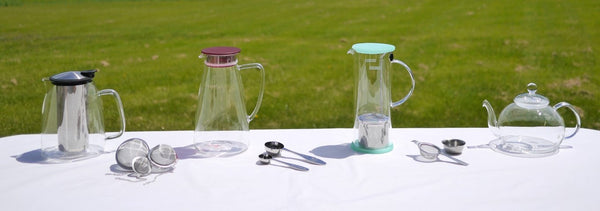


Fascinating – enjoyed reading the ways in which the different teas can be brewed and brewed correctly! Brewing black tea was easy enough for me but I could never really get brewing green tea – until now! Thanks for the clear instructions for brewing the Classic Sencha Green. What a difference it makes to the flavour when brewed in the right way, for the right length of time, at the right temperature. The ‘tone’ of the tea was just perfect. Have to order more! Thanks again. Latha Unny
Latha Unny
A very interesting post where we can see that, apparently an easy procedure, is very complex and, depending how you perform it, we will get different results!
Some years ago I discovered and learn it in a hard way: I did a black tea but I leaved it during a couple of hour. After that I drank it and it was soooo strong that I was not able to sleep during that night…
Anyway, nowadays, black tea is one of my favorite teas, has an absolutely delicious flavor, which I cannot find anywhere else and it is very easy to prepare according to the description above.
Thank you for sharing all of this information with us!
Catarina Bruno - Magic Tea Mail